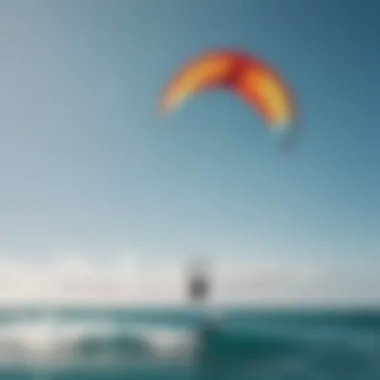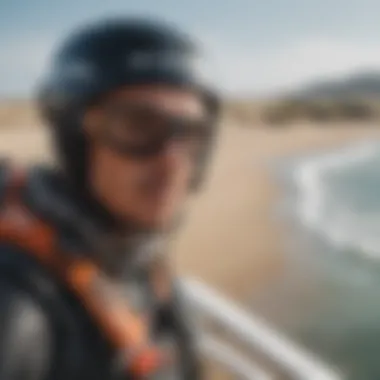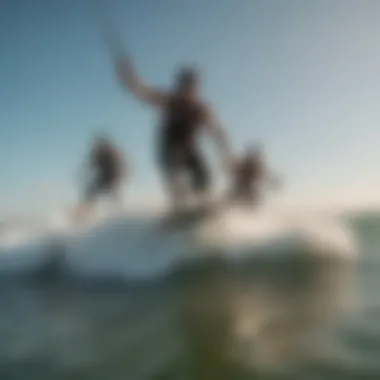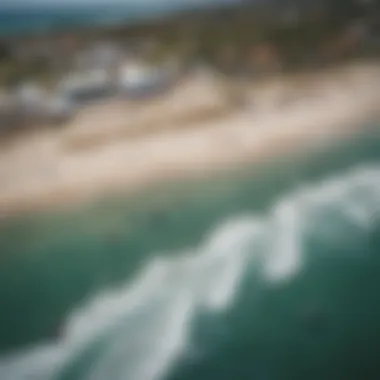Exploring Kiteboarding Terminology: Essential Insights


Intro
Kiteboarding, a sport that blends elements of surfing and paragliding, comes with its unique lexicon that reflects the community and its vibrant culture. To the uninitiated, these terms can seem like a different language altogether. This article aims to demystify kiteboarding terminology, ensuring that both rookies and seasoned practitioners can hold their own in conversations. Understanding the nuances in language allows for effective communication, safety discussions, and a more enriched experience on the water.
In this guide, we delve into the essential gear and equipment that every kiteboarder should know about, followed by techniques that both beginners and experts can utilize to master this thrilling sport.
Gear and Equipment
Essential Kiteboarding Gear for Beginners
Starting with the basics, kiteboarding gear is crucial for safety and performance on the water. Here’s a closer look at what novices should consider:
- Kite: This is the heart of kiteboarding. Beginners often opt for a basic inflatable kite as it offers stability in various wind conditions.
- Control Bar: This tool allows riders to steer and manage the kite. It's essential to pick one that feels comfortable in your hands.
- Harness: A comfortable harness distributes the load from the kite, enabling riders to enjoy longer sessions without unnecessary strain.
- Board: Typically a twin-tip board, great for beginners due to its ability to ride in both directions.
- Safety Gear: Helmets and impact vests protect against potential falls or collisions.
Proper selection and understanding of this gear can set the tone for a safe and enjoyable start.
Advanced Equipment for Experienced Riders
As riders progress, their needs change. Here are some advanced pieces of equipment that may become essential:
- High-Performance Kites: These include specific kites for freestyle, wave riding, or racing. Each style has a tailored design for better performance.
- Specialized Boards: From directional boards for surf conditions to freestyle boards with boot inserts, the options expand as skills develop.
- Bar Adjustments: Experienced riders often seek customized control bars that allow for faster reactions and refinements tailored to their style.
- Foil Kiteboards: These boards are becoming increasingly popular among seasoned kiteboarders seeking to explore the water in new ways, providing a unique experience off the wave and behind the kite.
Understanding the right gear at every level is essential not only for performance but for ensuring safety and confidence.
Techniques and Tips
Basic Riding Techniques for Newbies
When it comes to the terrain, learning the basics can make or break your initial kiteboarding experience:
- Body Dragging: This is often the first skill to master, where riders learn to control their kite while being pulled through the water.
- Water Starts: After understanding how to steer, the next step is getting on the board in the water. Finding the right angle of the kite can be the difference between an effortless launch and an exhausting struggle.
- Riding Position: Keeping a solid position on the board can improve balance and control, making the ride smoother.
These foundational techniques lay the groundwork for a confident in-water experience.
Expert Tricks to Elevate Your Skills
Once the basics are in your toolkit, it's time to kick it up a notch:
- Jumping: Utilizing the power of the kite to catch air requires understanding timing and kite positioning. Mastering this can feel like flying for the first time.
- Tricks like the Railey or KGB: These take practice but are essential in the world of freestyle kiteboarding. They not only impress but can be a game changer in competitive settings.
- Downlooping: A technique for turning while airborne—great for maintaining speed and control during aerial maneuvers.
Remember: Every expert was once a beginner; practice is key to making these skills second nature.
In summary, kiteboarding language goes beyond just the terms; it encapsulates the spirit of the sport itself. With a solid grasp of gear, techniques, and community lingo, kiteboarders can fully embrace the experience, create better connections, and push their limits both on and off the water.
Understanding the Basics of Kiteboarding Terminology
Understanding the terminology in kiteboarding is more than just a linguistic exercise; it serves as the foundation for effective communication among kiteboarders. Just like in any sport or community, jargon arises to streamline conversations and convey complex ideas with ease. When you dive into kiteboarding, knowing the lingo becomes essential not only for safety but also for maximizing enjoyment on the water. Learning these terms can help you ask the right questions, join discussions, and fully immerse yourself in the culture.
Key Concepts in Kiteboarding


In the world of kiteboarding, several key concepts stand out, each contributing to a deeper understanding of the sport. Terms such as "edging" and "downwind" describe specific techniques and maneuvers, while others like "kite control" and "wind window" define essential ideas that all kiteboarders should grasp.
- Kite Control: This refers to how a rider manages their kite to ride efficiently. Mastery over this concept can lead to smoother rides and better performance.
- Wind Window: An imaginary area where a kite can fly, determining where the kite can be effectively controlled.
Becoming familiar with these foundational terms will equip riders with the knowledge they need, laying the groundwork for skill development.
Evolution of Surfing Language
Over the decades, surfing language has evolved significantly, much like the sport itself. Originally, the terms used were local and specific, often exclusive to certain regions or communities. As kiteboarding gained popularity worldwide, the need for a common vernacular emerged.
- Cultural Exchange: The cross-pollination of ideas and terminologies between different surfing and kiteboarding communities contributed to a richer lexicon.
- Modern Influences: Social media and online communities like Reddit and various kiteboarding forums have accelerated this evolution, circulating terms rapidly and creating a global dialogue.
This linguistic transformation illustrates the dynamic nature of kiteboarding and its community, reflecting broader trends in culture and communication. The terms not only describe techniques but also encapsulate the vibes and ethos of the sport itself.
Equipment Terminology in Kiteboarding
Understanding the various elements of kiteboarding gear is crucial for anyone interested in the sport. Equipment terminology serves not just as a guide, but also as a bridge to better understanding and communication among riders. When you get the hang of those terms, it’s like having a secret decoder ring that opens up the fun and safety aspects of kiteboarding. Recognizing what’s what in terms of tools and safety gear can vastly enhance a rider's experience, clarify discussions during training, and promote a safer riding environment. This section dives into the specifics of kites, boards, harnesses, and more, unraveling the details behind each element.
Kites: Shapes and Sizes
Kites come in various shapes and sizes, each designed to cater to different riding styles and conditions. For instance, the most commonly used kite shapes are the C-kite and the Delta kite. C-kites are often chosen by more experienced riders for their performance in tricks and jumps. Their shape allows for sharp turns and great power control.
In contrast, Delta kites are more forgiving and stable, making them a favorite for beginners and those looking for a smoother ride.
When it comes to size, kites range from small 5 m² models to larger ones exceeding 15 m². The size of the kite plays a key role in how much power it can generate. Larger kites catch more wind, which translates to greater pull, while smaller kites are easier to handle in strong gusts. Understanding the outfit of kites is invaluable. More than just jargon, it’s about selecting the right gear to match your skill level and the conditions you’ll be hitting.
Boards: Types and Functions
Boards are the platform for your kiteboarding adventures, and just like kites, they come in a variety of designs tailored to specific styles. When selecting a board, you may hear terms like "directional" and "twin-tip," which signify how that board is meant to be used.
- Directional Boards are designed to be ridden in one direction, much like a surfboard. They excel in waves and provide a different riding experience, often preferred by experienced kiteboarders who enjoy wave riding.
- Twin-tip Boards are symmetrical and can be ridden in either direction. They allow for easier turns, making them popular among newbies and those looking to perform tricks.
Moreover, boards vary by their material and flex characteristics. A board with a softer flex provides more comfort over choppy water, while a stiffer board gives better responsiveness on flat surfaces. Knowing how to choose and what terms describe various boards can enhance performance and enjoyment on the water.
Harness: Role and Styles
The harness plays a pivotal role in kiteboarding as it connects you to the kite via the harness lines. The main job of the harness is to distribute the kite’s pull across your body, alleviating strain on your arms and allowing for better control.
There are a few types of harnesses that you can find:
- Seat Harnesses are usually favored by beginners. They sit lower on the body and enhance stability, which can be helpful when learning.
- Waist Harnesses allow for a greater range of movement, making them a choice for advanced riders who want to perform tricks.
Choosing the right harness influences comfort during sessions. A good fit is essential; an ill-fitting harness can cause discomfort and hinder performance on the water.
Lines and Safety Systems
Lines are the unsung heroes behind every kite operation. They connect the kite to the harness and control the movement of the kite. Typically, you'll have two main lines on each side: the front lines that connect to the leading edge and the back lines that connect to the trailing edge. Knowing the ins and outs of these lines is essential, especially when it comes to adjustments, tuning, and troubleshooting during a kiteboarding session.
Moreover, safety systems are integral to kiteboarding equipment. Terms like quick release and safety leash are vital for rider safety. The quick release allows the rider to disconnect from the kite rapidly in the event of an emergency, which can be a lifesaver.


The safety leash helps keep the kite from drifting away when unwarranted, such as in a crash or sudden fall. Recognizing these safety tools not only enhances your competence but greatly reduces risks while kiteboarding.
By mastering the vocabulary of equipment terminology in kiteboarding, you’re not just learning the lingo—you’re laying a solid foundation for expanding your skills and participating in the kiteboarding community with confidence.
Skills and Techniques: Terminology Breakdown
Understanding skills and techniques in kiteboarding not only elevates one’s performance on the water but also fosters a sense of camaraderie among riders. This section elucidates the essential vocabulary that defines various maneuvers and tricks, bridging the gap between novices and seasoned experts. With a firm grasp of this terminology, riders can communicate their skills effectively, share experiences, and master new techniques with precision.
Basic Maneuvers: Definitions and Contexts
Basic maneuvers are the building blocks of kiteboarding; they set the foundation for all tricks that follow. Gaining fluency in their terminology is crucial for every kiteboarder. Here are some key terms you need to know:
- Tacking: This is the act of steering against the wind to change direction while maintaining control. It’s like dance moves on water where timing is key.
- Jibing: Opposite to tacking, jibing involves shifting direction with the wind. It’s often smoother and feels like gliding from one note to another in music.
- Jumping: Arguably the most thrilling basic maneuver, jumping requires a solid understanding of kite positioning. This is where you harness the power of wind to launch into the air. The common phrase “pop and pull” captures the essence of this action.
To execute these foundational moves well, riders must practice; repetition makes perfect. Understanding how wind interacts with the kite is vital. It’s not just about navigating waves; it’s about mastering the air. Proper terminology fuels communication, helping riders discuss specifics of what went right or wrong during a session.
Advanced Tricks: A Specialized Lexicon
Once the basics are conquered, kiteboarders often seek to push their limits with advanced tricks, where vocabulary becomes specialized. Adopting these terms can elevate the discourse among enthusiasts:
- Kite Loop: A daring maneuver that involves spinning the kite rapidly in a loop while jumping. The thrill here is not just in height but also in the kite’s frenetic dance through the sky.
- Handle Pass: This requires the rider to pass the control bar from one hand to another mid-air. Think of it as a trust fall, but in reverse — precision and timing are key.
- Back Mobe: A complex trick that blends jumping and spinning backward. It’s as challenging as it sounds and takes countless tries before it becomes second nature.
Each of these terms carries weight within the kiteboarding community. Knowing these concepts allows riders to share tips and experiences with clarity. It creates a sense of belonging and helps foster mentorship among the varying skill levels.
"In the world of kiteboarding, every term has its place, and the right words can amplify the thrill of sharing a sport that’s as much about camaraderie as it is about individual skill."
Understanding the specialized language surrounding advanced techniques not only enhances personal performance but also solidifies social ties within the community. So, the next time you find yourself on the water with fellow kiteboarders, you’ll not just be riding the waves; you’ll be speaking the language of the sport.
Conditions and Environment Terminology
Understanding the conditions and the environment is critical for anyone who loves kiteboarding. The interplay between wind, water, and terrain can dictate not just the enjoyment of the sport but also safety and performance levels. This section dives into the specific jargon used in these contexts, helping riders navigate their experiences more effectively.
Wind Conditions: Terms Every Rider Should Know
Wind conditions can make or break a kiteboarding session. Familiarizing oneself with terms like "upwind", "downwind", and "crosswind" is essential.
- Upwind refers to riding toward the wind, which requires strength and skill.
- Downwind denotes the opposite, making it simpler to glide and conserve energy.
- Crosswind indicates a riding angle perpendicular to the wind's direction; it’s the sweet spot for many riders performing tricks.
Knowing wind speed is also paramount. Terms like "light breeze" (1-12 knots) and "strong wind" (over 25 knots) help define the kite size needed. Additionally, understanding gusty conditions is vital since sudden increases in wind speed can surprise even seasoned riders.
"In kiteboarding, the wind is your lifeblood. Understanding its nuances can elevate your skills from mediocre to exceptional."
Water Conditions: Understanding the Elements
The state of the water is just as important as the wind. Kiteboarders must be aware of terms like "chop", "flat", and "waves".
- Chop refers to small, irregular waves, commonly found in windy conditions. It can create a rocky ride but can be manageable if the right skills are employed.
- Flat water is ideal for beginners and those looking to practice tricks, providing a smoother ride.
- Waves present both challenges and excitement. The terminology varies—there's "shore break" (waves crashing on the beach) and "rolling swell" (the gentle rise and fall of waves). Each condition demands different techniques, both in terms of navigation and safety.
Surf Zones: Terminology and Navigation


Navigating through surf zones involves knowing your environment well. Key terms like "launch area", "downwind zone", and "rider's right/left" come into play.
- Launch Area is where kiteboarding starts; it’s crucial to respect this space, especially in crowded spots.
- Downwind Zone refers to the area where riders will drift with the wind currents, making it vital to plan launches and landings accordingly.
- Rider's Right/Left helps communicate directions among fellow riders, contributing to a smoother and safer experience out on the water.
Understanding these terminologies not only equips riders with the knowledge they need but also encourages a culture of safety and camaraderie within the kiteboarding community.
Community and Cultural Terminology
Understanding the social fabric of kiteboarding extends beyond the mere mechanics of riding. The community and cultural terminology specific to this sport lays the groundwork for a shared language among enthusiasts. This vernacular serves not just as a means of communication but also as a marker of identity and belonging within a diverse and universal culture.
Diving into kiteboarding lingo is like peeling back the layers of an onion. Each term not only describes equipment or techniques but also evokes a sense of camaraderie and collaborative spirit amongst riders from all walks of life. This shared understanding enables kiteboarders to connect with each other more deeply, whether they're just starting out or are seasoned pros. Ultimately, it contributes to enriched experiences on the water and fosters an inclusive environment for everyone involved.
Kiteboarding Lingo: A Social Context
Kiteboarding has its own colorful lexicon, and getting a grasp on this language can yield multiple advantages. For one, it helps build rapport among fellow kiteboarders. Terms like "hucking," which refers to launching off the water, or “freestyle,” which describes tricks performed during riding, carry with them a sense of authenticity and community cohesion. Knowing and using these terms can open doors to conversations where riders can exchange tips, tricks, and personal stories - enabling newcomers to feel less isolated in this exciting venture.
Moreover, the local kiteboarding culture is often reflected through its distinct terminology. Different regions may adopt variations or slang that are unique to their scene. For instance, in Brazil, the term "abdominal" might refer to a popular trick, while in the Caribbean, "kook" might be humorously used to describe a newbie not yet familiar with the etiquette of the water.
Understanding and utilizing local slang not only aids in navigating the community but also solidifies one's status as a genuine participant in the kiteboarding world. It showcases a conscientious effort to engage with the culture, enhancing not just communication but friendships formed through a common passion.
Events and Competitions: Terminology Overview
Kiteboarding events, whether local competitions or international showcases, come with a language of their own that has evolved over time. From judging criteria to event organization, being familiar with the terms used in competitions is crucial for participants and spectators alike. Knowing phrases like "heat," which refers to the different segments of the event, or “judging panel,” which is the group responsible for scoring riders, can vastly improve one’s experience.
Additionally, competitive terminology underscores the blend of sport and art inherent in kiteboarding. Riders are often scored based on difficulty, execution, and style, making terms like "technical moves" and "style points" essential in discussions regarding performance. Understanding these distinctions helps riders set goals and refine their skills based on what judges are looking for. Such knowledge may ultimately be the difference between a good ride and a phenomenal one.
To summarize, the community and cultural terminology encapsulated in kiteboarding is not just about words or technical jargon; it's about connection, identity, and shared experience. As the sport continues to grow, so too does its language and culture, inviting more to join in, learn, and contribute.
"The language we use in kiteboarding not only communicates technical skills but also weaves the very fabric of our community."
Engagement in this unique dialect can enhance every aspect of kiteboarding - from social interactions to competitive success.
Ending: The Importance of Terminology in Kiteboarding
Kiteboarding, much like any other sport, has its own specialized language that reflects the unique culture and dynamics of the community. Understanding this terminology is not merely an academic exercise; it serves as a vital tool that bridges gaps between riders—whether they’re seasoned pros or still finding their footing on the water. The intricate web of terms and jargon encapsulates years of evolution in both technique and community practices, making it important for every kiteboarder to grasp.
When you hear a fellow rider refer to a "kite loop" or mention the term "downwind," it’s not just casual chatter—this language reflects a collective understanding and shared experiences. It reinforces camaraderie among enthusiasts, helping them relate better to one another and communicate effectively in both casual settings and during high-pressure situations, like competitions. A well-informed rider can easily share insights and advice, fostering a supportive environment where everyone can grow and excel.
Enhancing Communication Among Enthusiasts
Communication is vital in any sport, and kiteboarding is no different. The terminology serves to streamline interactions, making it easier to discuss various aspects of riding. For instance, knowing the difference between "overpowered" and "underpowered" helps riders understand their equipment's performance under different conditions. This knowledge can save a beginner from a precarious situation where they might attempt a trick while struggling against an unforgiving wind, thus avoiding potential accidents.
Moreover, this lingo also creates a sense of belonging. When novices adopt the language of experienced kiteboarders, they are welcomed deeper into the culture. Enthusiasts might find themselves absorbing knowledge faster and feeling more confident to engage in communal activities. The shared dialect becomes a sort of badge of honor that marks one's dedication to the sport.
"Fluency in kiteboarding lingo isn’t just about sounding cool—it’s about authentic connection and safety on the water."
The Role of Vocabulary in Skill Development
Vocabulary is more than just a collection of words; it’s a conduit for conveying techniques and strategies essential for skill enhancement. Each term has its own layers of meaning, often encompassing specific techniques or mentalities required for mastery. For example, the term "stance" doesn’t merely refer to how you stand on the board; it directly impacts balance, control, and the ability to maneuver with finesse.
Understanding this nuanced terminology allows riders to dissect their own performances and identify areas for improvement. When a budding kiteboarder hears about transitions, they begin to envision not just the technical movement but also the timing and positioning required to execute it flawlessly. As they decode these terms, they learn to visualize the process, ultimately leading to faster skill acquisition.
Furthermore, as riders delve further into advanced techniques, the specificity of vocabulary can demystify complex maneuvers. Terms like "megaloop" or "handle pass" present clear ideas that give aspiring riders tangible goals to work towards. This clear framework encourages riders to challenge themselves constructively, thus contributing to their overall development in the sport.
In summary, the importance of terminology in kiteboarding cannot be overstated. Not only does it bolster communication among enthusiasts, but it also plays a crucial role in the individual growth of riders, enhancing both their understanding of and their proficiency in this exhilarating sport. This shared language doesn’t just enrich the sport; it transforms the kiteboarding community into a more inclusive and supportive fabric that invites everyone to ride the waves together.















